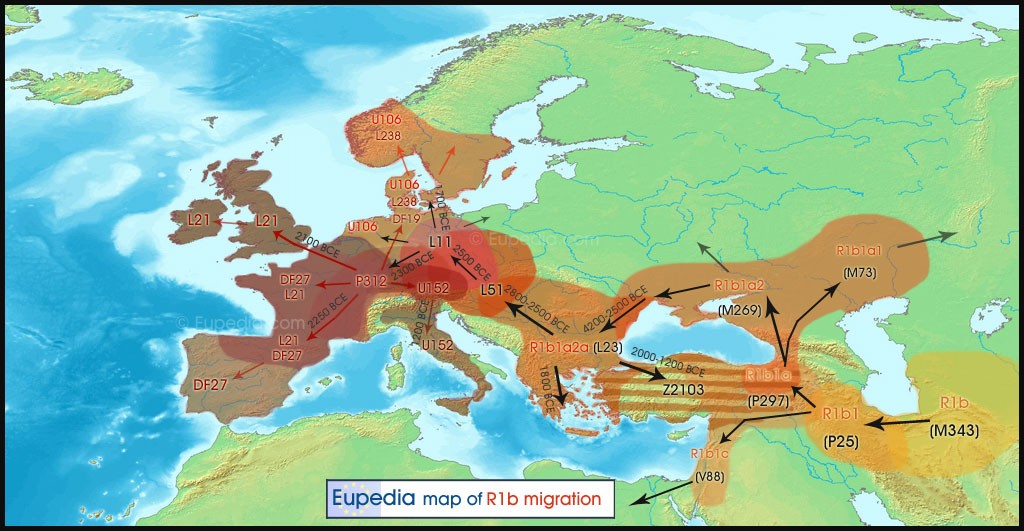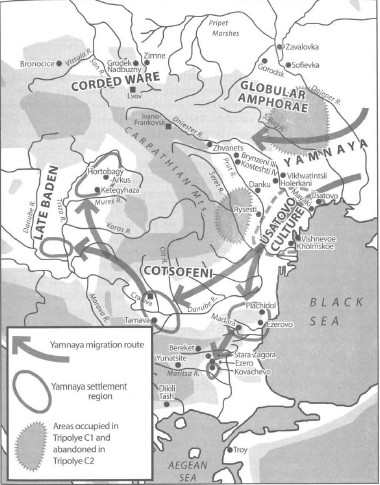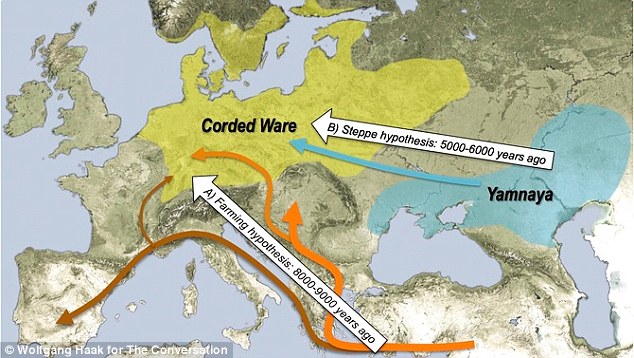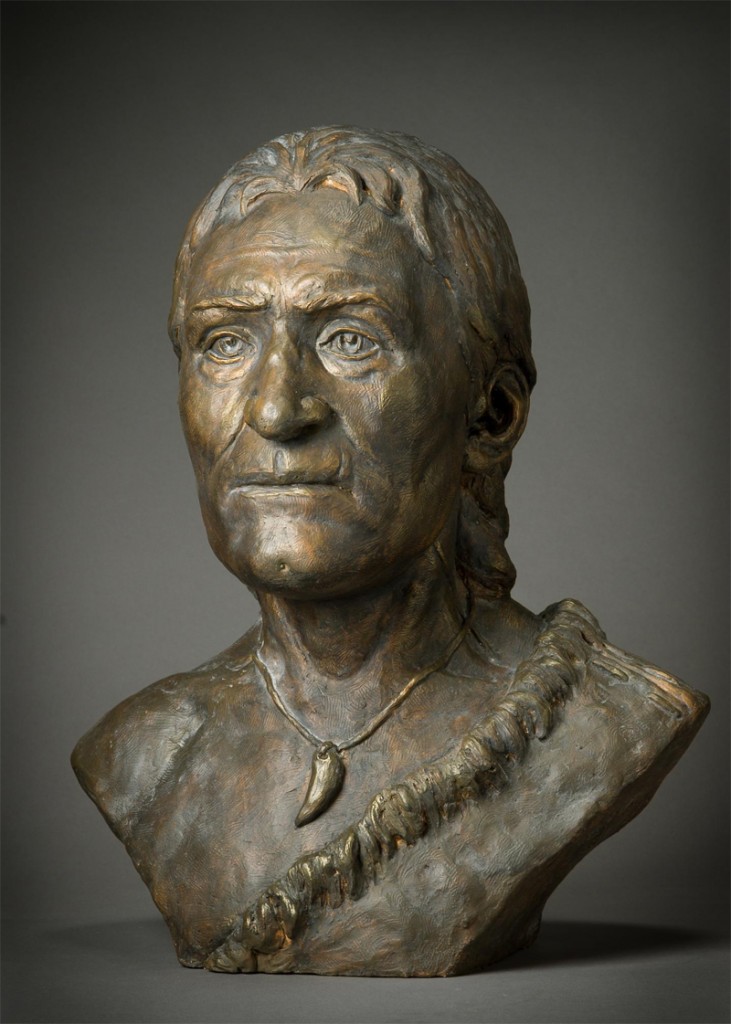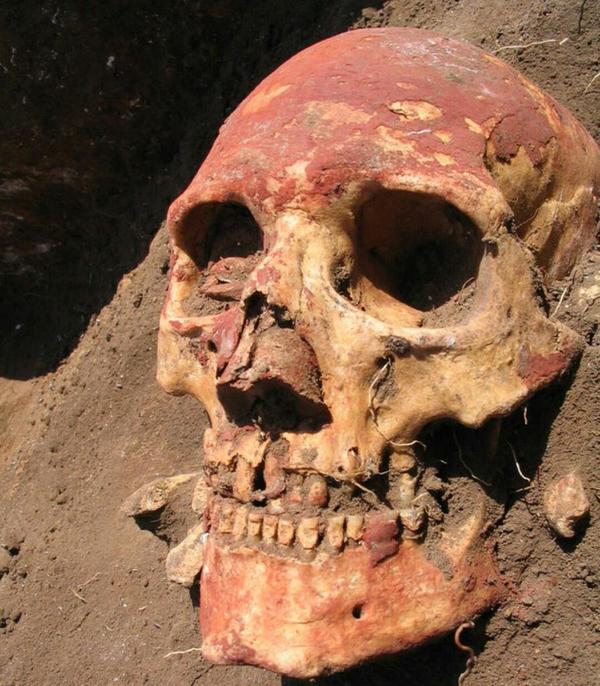R1b-DF27.com
Indo-European Y-DNA Haplogroup

Yamnaya Culture (3000-2400 BC)
The Yamnaya Culture was predominately R1b
R1b & Yamnaya Culture History
Yamnaya Genetics:
DNA from the remains of nine individuals associated with the Yamna culture from Samara Oblast and Orenburg Oblast has been analyzed. The remains have been dated to 2700–3339 BCE. Y-chromosome sequencing revealed that one of the individuals belonged to haplogroup R1b1-P25 (the subclade could not be determined), one individual belonged to haplogroup R1b1a2a-L23 (and to neither the Z2103 nor the L51 subclades), and five individuals belonged to R1b1a2a2-Z2103. The individuals belonged to mtDNA haplogroups U4a1, W6, H13a1a1a, T2c1a2, U5a1a1, H2b, W3a1a and H6a1b. A 2015 genome wide study of 94 ancient skeletons from Europe and Russia concluded that Yamnaya autosomal characteristics are very close to the Corded Ware culture people with an estimated a 73% ancestral contribution from the Yamnaya DNA in the DNA of Corded Ware skeletons from Germany. The same study estimated a 40–54% ancestral contribution of the Yamnaya in the DNA of modern Central & Northern Europeans, and a 20–32% contribution in modern Southern Europeans, excluding Sardinians (7,1% or less) and to a lessor extent Sicilians (11,6% or less).[4][7][8]
Sources: Wikipedia
R1b entering Europe
When R1b people entered Europe and brought the Bronze Age, “They replaced the old Neolithic farming cultures with their completely new perception of family, property and personhood”. Source: Professor Kristian Kristiansen of the University of Gothenburg.
The re-writing of the genetic map [of Europe] began in the early Bronze Age, about 5,000 years ago. From the steppes in the Caucasus, the Yamnaya Culture (R1b) migrated principally westward into North- and Central Europe, and to a lesser degree, into western Siberia. Yamnaya was characterized by a new system of family and property. In northern Europe the Yamnaya mixed with the Stone Age people who inhabited this region and along the way established the Corded Ware Culture, which genetically speaking resembles present day Europeans living north of the Alps today.
(http://www.ancient-origins.net/news-evolution-human-origins/when-modern-eurasia-was-born-genetics-yield-clues-origins-eurasians-020391)
R1b Haplogroup
R1b first shows up about 22,000 YBP (Years before present)
Y-DNA Haplogroup Tree Resources:
Ybrowse – http://ybrowse.isogg.org/ – Thomas Krahn
YTree – http://www.ytree.net/ – Alex Williamson
FTDNA – http://www.familytreedna.com/ –
YFull – http://www.yfull.com/ –
Sample Kit 07
Sample Kit #07 Results (Z198/L176.2* as of 7/28/2015)
Z198+ (mutation discovered in 2011 by citizen scientists investigating 1k genomes project)
L176.2+ (mutation discovered in FTDNAs research lab in 2011)
SRY2627- (first found in 1997, one of the first; downstream of Z198 & L176.2)
L165- (downstream of Z198 & L176.2, parallel to SRY2627)
CTS4188- (downstream of Z198 & L176.2, parallel to SRY2627)
** [ZS312/M7953 unknown – downstream of Z198 & L176.2, upstream of SRY2627]
Negatives:
Z262- (subgroup of ZS312)
A477- (subgroup of ZS312)
CTS9993- (subgroup of ZS312)
M3920- (subgroup of ZS312)
S11121-
Reference: familytreedna.com/public/R1b1c6
